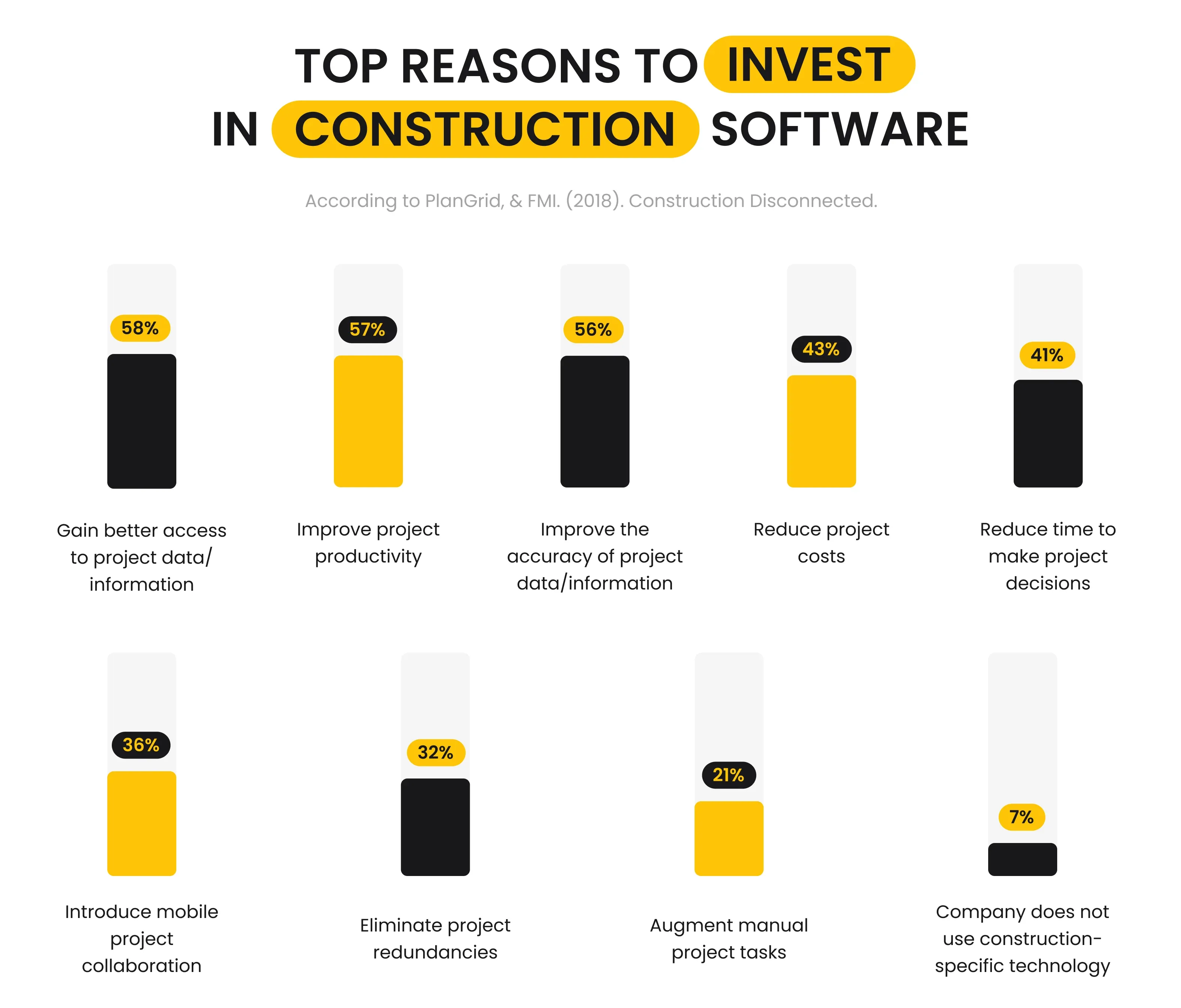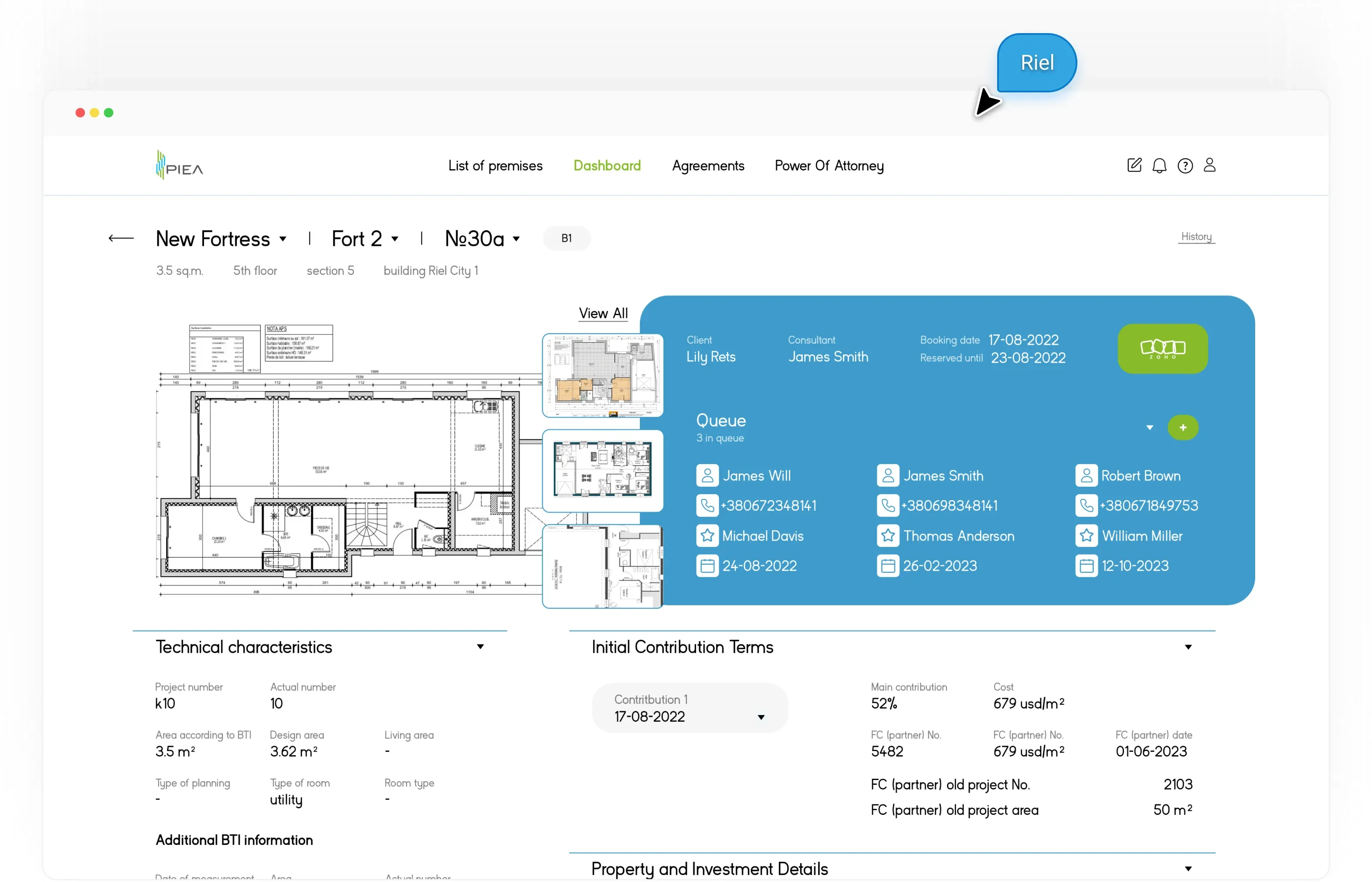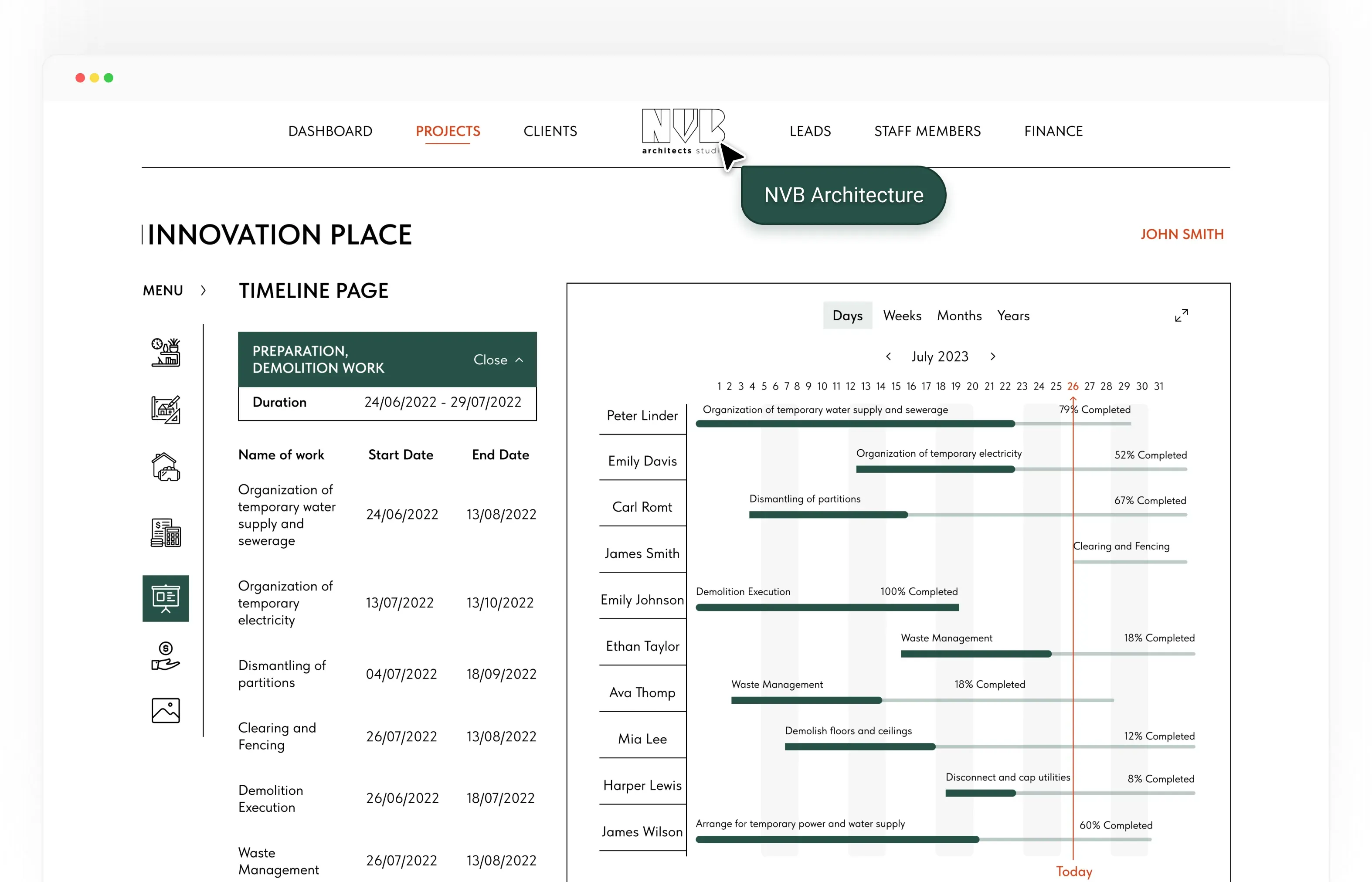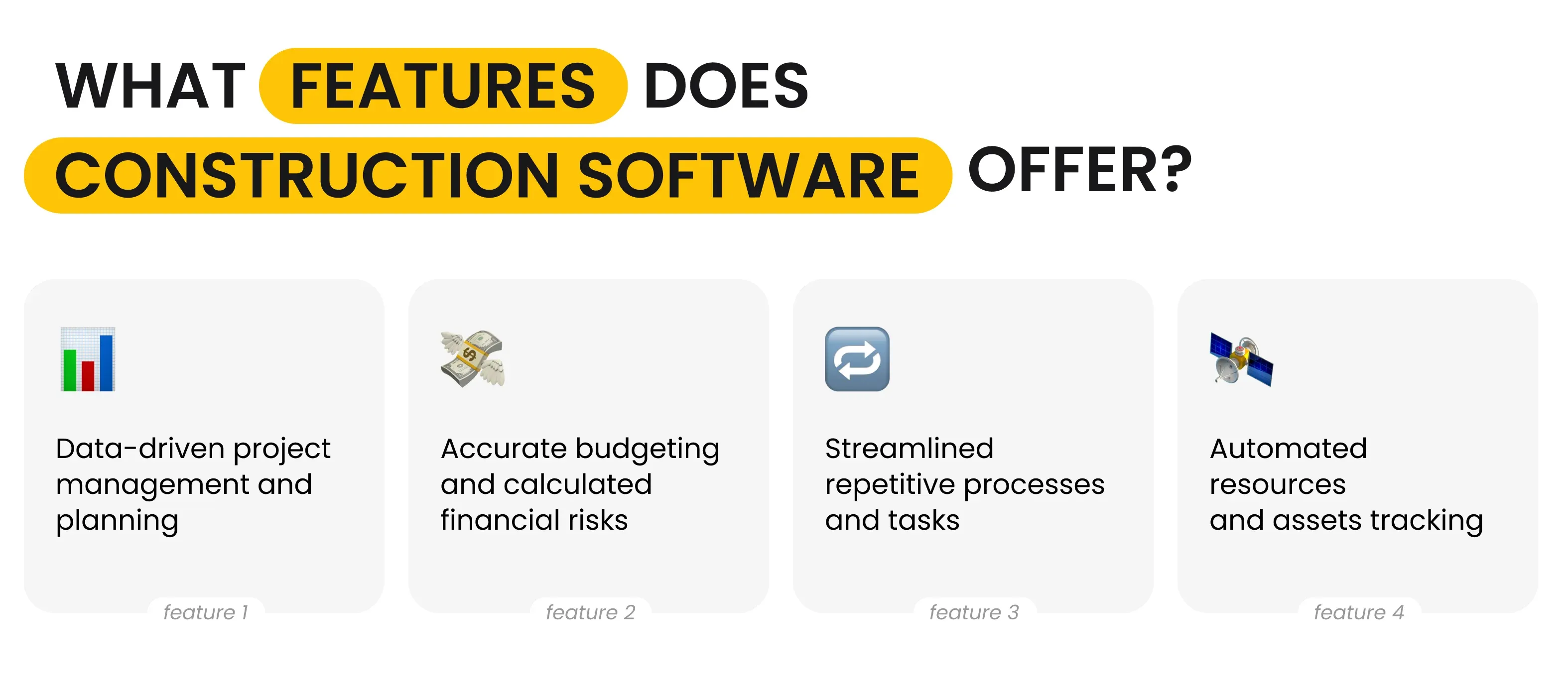Construction
Real Estate
How Construction Workflow Management Software Helps to Reduce Costs and Boost Efficiency?
July 04, 2025 • 115 Views • 23 min read
Tetiana Stoyko
CTO & Co-Founder
Every business aims to reduce operational costs and achieve as high efficiency as possible. Fortunately, the modern IT industry offers countless ways to achieve such goals and optimize even niche-specific services and processes thanks to modern software solutions.
For instance, in the real estate and construction fields, businesses can significantly benefit from adopting construction workflow management software. Such tools help streamline multiple repetitive and routine tasks, including data management, sharing, and analysis.
Nevertheless, one of the core challenges of integrating innovative software solutions is to ensure that such technologies are user-friendly and intuitive. Most employees of construction companies are not tech-savvy, especially those working on-site.
Therefore, it is crucial to ensure that using such software is easy and convenient for them. Otherwise, regardless of how useful and innovative construction workflow automation software is, it won’t bring value due to staff turnover.

For instance, according to the latest Autodesk report, 22% of construction technology integration failures are due to their complexity and difficulty of use. Still, it is not the only challenge of adopting new software solutions for construction workflow management. Additionally, these issues can be easily addressed by hiring an experienced software development team.
Instead, let’s pay more attention to the benefits and reasons why your business should consider such integration or scale the existing systems. However, we must first consider the core challenges of construction business operations and how modern technologies help to overcome them.
Current Challenges in Construction Business Operations
One of the significant reasons why construction companies spend more resources than expected is the poor data and miscommunication between different teams. These reasons were the cause of 48% of construction rework cases in the US, according to the same Autodesk report.
The impact of inefficient data-related operations and poor communication can be traced to the following challenges:
- Inefficient project management and planning
- Cost overruns and financial risks
- Delays due to manual processes
- Difficulty in tracking resources and assets
Fortunately, most of these issues can be easily resolved through the proper integration of construction workflow management software.
Inefficient Project Management and Planning

Any project management highly relies on efficient communication and up-to-date information on the subject. Issues with just one of these factors can significantly affect the efficiency and accuracy of every planning routine, ranging from tracking the progress of ongoing processes to general project estimation or feasibility analysis.
In turn, a lack of construction project management efficiency results in deadlines being overdue and overspending or insufficient budgeting. Combined with the overall importance of operations planning and monitoring, inefficient project management can cause significant problems on-site, which can also trigger other issues and potentially lead to the project's collapse.
Construction workflow automation software can’t address all issues and guarantee a 100% success rate in project planning and management. However, it can still help to significantly reduce the occurrence of such problems while also providing teams with tools and ways to counteract them.
The first and most obvious way to protect your construction management workflow is to provide your employees with a centralized platform that will support clear and straightforward internal communication. It is also possible to enable useful built-in features, such as file sharing and support for Building Information Modeling (BIM).
Project managers and other remote employees will significantly benefit from dashboards and other analytical tools that utilize real-time data and visualize it for improved understanding and clarity of procurement reports, as well as other complex analyses and industry-specific information.
Finally, it is worth implementing various progress-tracking methods and approaches, such as to-do lists, Kanban-like boards, or other project management software for construction industry.
Cost Overruns and Financial Risks

Poor data and communication can also cause cost overruns and financial risks. Nevertheless, most commonly, they result from inefficient project management and planning, as such issues primarily depend on inaccurate estimation and planning, not raw, unprocessed data.
So, if you secure your project management and planning, you will already decrease the possibility of such risks or mistakes. Still, it doesn’t mean that you can’t also enhance financial management and tracking by using construction workflow management software, automated procurement reports, or even integrations with popular procurement marketplaces.
For instance, to reduce the load on your project and financial managers, you can scale your construction software solution by implementing tools for automated cost estimation and budgeting or providing them with more advanced instruments for real-time expense monitoring.
Unfortunately, many construction companies avoid such options and stick with more traditional methods to manage their finances, commonly using various off-the-shelf FinTech solutions, even if they are outdated. Even in such cases, it is possible to achieve higher transparency and accuracy by linking these independent systems through APIs or via simple custom software development projects.
Integrating financial management into a centralized construction workflow management software platform helps to reduce repetitive tasks, such as copying data into different systems. Apart from reducing the need for manual tasks, it also helps to avoid potential mistakes and errors, as well as input duplicates.
Delays Due to Manual Processes
One of the most significant reasons to invest in proper software development for the construction industry is the possibility of construction workflow automation.

Software-driven operations can be easily standardized and streamlined by creating templates and rules for various reports, notifications, or other repetitive processes. Such software automation can also be applied to multiple aspects of operations, such as approving processes and granting access to specific data, thereby eliminating administrative bottlenecks and unnecessary waiting time.
Besides, automated operations can vary depending on your business needs and goals. For example, apart from streamlining niche-specific processes, you can also utilize software to manage other business aspects, such as customer support services, marketing, or sales operations.
NOTE: Automating unrelated business processes will require independent software projects.
The possibility of streamlining operations doesn’t mean that you should automate all of them. Some crucial or complex tasks should stay manual. Yet, by reducing the number of manual processes, you can significantly reduce operational delays and allow your employees to prioritize more urgent or vital assignments.
Difficulty in Tracking Resources and Assets
Finally, construction workflow management software can be used to enhance awareness of resource allocation and improve asset management through collaboration with third-party software, such as procurement marketplace integrations.
On a basic level, it is sufficient for a construction company to create a centralized database linked to various management systems. By creating a “single source of truth”, a construction company can eliminate confusion and manual record-keeping by simplifying the accessibility and transparency of inventory management, allowing construction workers to update asset status with just a few clicks.
Apart from that, it is worth ensuring the quality and usability of industry-specific services such as BIMs or other similar tools. For instance, PlanRadar offers a unique and highly efficient BIM feature that helps plan the next construction steps more effectively, such as interior build-out. This feature provides on-site employees with a 3D visualization of building plans and on-map activities.
Therefore, teams can better cooperate, managers can easily track the progress of various aspects of the construction site, and builders can recheck the assignment and its specifics on-site, preventing possible mistakes and errors, which ultimately saves time and resources.
Alternatively, with sufficient investments, businesses can achieve significantly higher resource allocation and inventory tracking by adopting more complex hardware solutions and tracking technologies, such as GPS trackers, Radio Frequency Identification (RFID), or Internet of Things (IoT) solutions, including smart sensors and QR codes. Yet, this is an optional solution, primarily suitable for enterprise-level construction firms rather than small or mid-sized businesses.
Real-Life Examples of Construction Workflow Automation
For a better illustration of how all these software-driven features and services can help your construction company reduce costs and improve business efficiency, let’s consider some of our latest case studies.
However, before we go deeper into the subject, we would like to highlight that despite the benefits and value of implementing all the foregoing software solutions, you don’t have to do it all at once. Instead, you can choose a Minimum Viable Product (MVP) or similar budget approaches to gradually scale the functionality. Still, you should always start by enhancing internal communication and data operations, as they are the core reasons for most performance issues and additional expenses.
Boosting Efficiency by 40% with ERP Optimization
Our first construction software case, Riel, involved optimizing an existing construction management system and scaling its functionality.

When our developers joined the project, our clients already had an existing ERP system for the construction industry. The core goal of our cooperation was to integrate an AI-driven chatbot to improve customer support services and automate the answering of Frequently Asked Questions (FAQs).
The idea behind this project was simple: by streamlining routine tasks, our client was able to reduce the workload on the customer support team and assign specialists to more valuable and urgent tasks.
However, during the project discovery phase, our software engineers noticed that the core IT infrastructure was outdated, which:
- Limited options for software scaling and integration of new technologies.
- Negatively impacted the overall performance of the system, commonly resulting in freezes and bugs.
So, instead of simply integrating new features, we offered a more comprehensive software development approach, which included system optimization and refinement, as well as best quality assurance practices to ensure the issues were resolved. The reason for such a choice is simple: due to poor optimization, the core features for construction workflow management underperformed. Yet, even the simplest coding practices, such as writing cleaner code, helped ensure more seamless operations.
Additionally, since the must-have features were already implemented, we prioritized less industry-specific solutions that could help boost the business's overall efficiency. During our conversations with the client, we determined that customer support services require a significant amount of time and resources.
Therefore, we suggested integrating a custom AI-driven module that would function as a chatbot, streamlining the most time-consuming tasks, such as answering Frequently Asked Questions (FAQs). Yet, the existing system was partly outdated, so we also had to perform some coding before starting the integration.
Apart from that, to ensure the accuracy of AI answers, we collaborated with the client’s team to design the dataset for the artificial intelligence, gather all essential information, and ensure that the model doesn’t “hallucinate” if it has no ready answer.
After training the model and making slight adjustments to the IT infrastructure, we proceeded to integrate and set up the automated customer support system. Therefore, if the users’ questions are basic, an AI module can answer them independently. However, if the question is specific or requires a personalized approach, it redirects the customer to a customer support specialist.
As a result, all our collaboration practices (system optimization and improvement, AI module integration) helped to achieve an incredible 40% operational efficiency boost. Primarily, though, the general performance improvement was a direct result of the software system’s optimization.
On the other hand, the customer support bot also significantly reduced the workload on this department, enabling it to prioritize more urgent and complex tasks, thereby boosting customer satisfaction.
Increasing Lead Conversion by 30% with a Centralized Platform
Another example of how construction workflow management software helps boost the efficiency of a construction business is our latest custom development project, which involved creating a centralized CRM platform from scratch.

Our clients faced challenges in managing and analyzing customer interactions, as well as lead conversion and generation. They used one of the popular construction SaaS solutions, which covered all industry-specific processes, yet lacked a CRM system or related services and features.
During our discovery and conversation stage, we explained all potential solutions, and the clients chose to invest in a software development project from scratch, defining and describing the software specifics and project expectations.
As a result, our development team was in charge of designing and developing a custom-made CRM for construction company, capable of not simply tracking leads but also providing our clients with some extra features and services, including convenient dashboards and data analytical tools, automated data gathering and processing, as well as additional services for tracking the performance of employees.
Additionally, we enabled data gathering from various niche-specific platforms to set up automatic updates on the market situation, providing our clients with more accurate and up-to-date insights into recent market trends and updates.
After adopting this custom software solution and using it for a few months, our clients gladly reported that their lead conversion rate rose by 30%. They also stated that, thanks to these instruments, they now have a better understanding of their target audience and its needs, which provides an opportunity to further improve customer service and satisfaction.
What Makes Incora a Great Fit for Construction Companies
As we can see, not all construction workflow management software solutions are highly specialized for the industry. Most software-based management tools are general and suited for multiple niches simultaneously, yet they often require adjustments and unique features to better address specific business needs or expectations.

So, when it comes to finding technological partners capable of delivering high-quality construction workflow management software, you should always pay attention to:
- Their previous experience in overall software development.
- Expertise in your particular field (construction or real estate).
Hiring industry-specific software developers is always a good choice, as it guarantees compliance with regulations and job-specific requirements. However, don’t forget that the overall expertise in software development is a much more important factor: as our examples show, it is possible to adjust and remake an existing system to address particular business needs.
Clearly, it is better to ensure such compliance from the outset, thereby avoiding unnecessary time and resource expenditures. However, redesigning and optimizing a poorly developed system is a much more complex and resource-intensive task. Therefore, we suggest prioritizing quality over industry specifics.
Nevertheless, if you are looking for IT services for the construction industry that can offer both technological expertise and industry knowledge, you have come to the right place.
Incora's software development team has extensive experience in creating a wide range of software solutions that address even the most specific and unique business needs and requests.
Additionally, among our most recent cases, there are numerous projects specifically tailored to the real estate and construction sectors. For instance, our company was recognized by Clutch as one of the top real estate software development companies worldwide.
If you have any ideas for a construction workflow management software project but don’t know how to get started, you can use the brief guide below or simply drop us a line with the details, and we will gladly advise you on the next steps.
What’s your impression after reading this?
Love it!
11
Valuable
6
Exciting
3
Unsatisfied
1
FAQ
Let us address your doubts and clarify key points from the article for better understanding.
How can software help automate construction operations?
Software can automate construction operations by streamlining project management, scheduling, equipment tracking, and reporting - reducing manual work, improving accuracy, and increasing overall efficiency.
How can AI be used in construction automation?
AI can be used in construction automation to optimize scheduling, predict delays, monitor safety, analyze site data, and manage resources more efficiently through real-time insights and machine learning.
What kind of ROI can we expect from automating our construction processes?
Automating construction processes can deliver an ROI of 20–40% through reduced labor costs, faster project completion, fewer errors, and improved resource utilization.
Can you automate construction processes using our current systems?
Yes, many construction processes can be automated using our current systems by integrating automation tools, project management software, or AI modules - though some upgrades may be needed for full optimization.
you may also like
Management Systems
Construction Project Management Software for Small Business: Complete Guide
Real Estate
How to Select the Right Construction Management Software for Your Business
Management Systems
Simple Construction Software for Construction Planning: Case Study
Real Estate
Clutch: Incora Is Among the TOP 10 Best Real Estate Software Development Companies Worldwide!
Real Estate App Development vs Web Development: Which is Right for Your Business?
Must-Have Features for Successful Real Estate Mobile App Development in 2024
Let’s talk!
This site uses cookies to improve your user experience. Read our Privacy Policy
Accept
Share this article